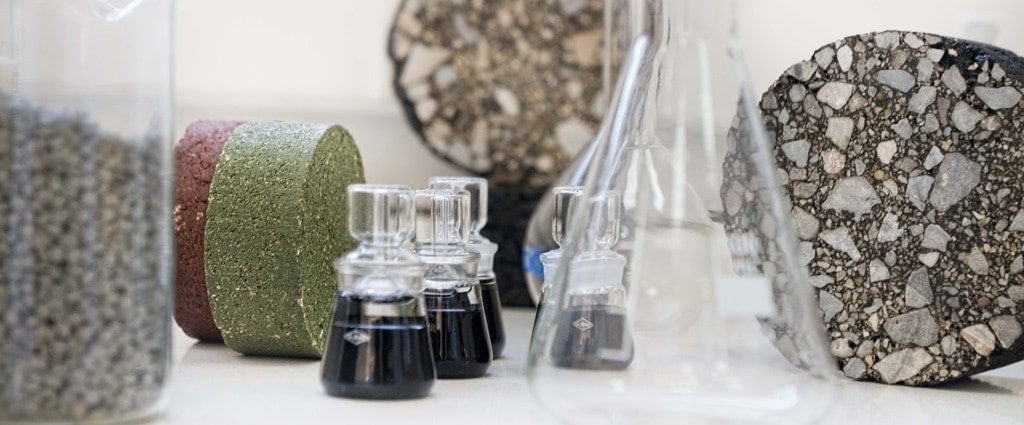
The path to the introduction of green pavements for the environmental and economic benefit of society
12 of January of 2016
Traffic levels have risen noticeably in our society in recent decades, and it is currently extremely common for a family to have several cars, drastically changing our way of life – a far cry from the days when we used to play in the street only stopping once every hour to let a car pass.
Our cars drive on what is known as the wearing course; asphalt road surfacing is normally made up of three layers: the base course, intermediate course and surface course. These layers are made up of two fundamental elements, aggregate and asphalt bitumen which acts as a binding agent. Frequently the bitumen used on the wearing course has been modified with unrecycled plastics (polymers). Some years ago, Ferrovial built a motorway in Almeria using bitumen modified with a plastic sourced from the roofs of agricultural greenhouses, which was manufactured by the subsidiary Ditecpesa Productos Asfálticos. This proved to be a highly satisfactory project given that it brought about substantial environmental savings and a pavement of excellent characteristics, with the project being the subject of a conference at the 1st Andalusian roads Congress in 1998.
Since then the roads sector has made great advances, although one great challenge that remains is for said advances to be more widely implemented, whether due to end clients’ resistance to innovation or even, on some occasions, owing to a fear of failure on the part of the companies carrying out the road surfacing when faced with undertaking something new.
In my opinion, from an environmental point of view, the most powerful application is the use of recycled road surfaces. Often, when the old pavement is removed (milling), this is taken to the dump to be then replaced by a completely new surface. Whenever I am driving along the motorway and I notice the mouth of an aggregate quarry gaping in the hillside, I ask myself how much that might have been avoided if there was a higher recycling ratio. Completely tried and tested procedures exist for using the old road pavement which, combined with the new mixture, results in a road surface that is identical to the original. It so happens that neither aggregates nor bitumen deteriorate significantly during the lifetime of the road surface, and as such their reutilisation is something which should be mandatory at a practical level both in terms of sector experts and society. Spain, which is one of the countries which makes the best road pavements, fails dismally in this respect, while countries such as the US have really done their homework, attaining a very high recycling ratio; according to a study from the National Asphalt Pavement Association (NAPA), carried out at the request of the Federal Highway Administration (FHWA), the use of recycled pavements in the US accounted for savings of around 2,000m USD in 2013. Recycling is also of note in Holland, standing at 70%, although in this case it is largely the result of the fact that the country does not dispose of many sources of aggregate.
Another application of enormous interest is the manufacturing of asphalt mixtures at lower temperatures; the standard temperature for the mixing of bitumen asphalt with aggregates tends to be between 160-180ºC, but techniques exist which can lower this temperature by 40ºC or more. Once again the US is the leader in this technique, where 30% of recycled mixtures are manufactured at low temperatures, with subsequent economic savings attained by bringing down the cost of heating the aggregates and bitumen.
One application which, although to date only in low numbers, is now fairly common in Spain, and which looks to have a favourable future, is the manufacture of bitumen modified with tyre powder from end-of-life tyres. For the Madrid M-503 highway, Ferrovial, which actively uses this technique, reused 22,000 tyres, and currently for the Olivar motorway it is going to recycle 11,000 tyres. Furthermore, these road surfaces modified with tyre powder are capable of providing properties that are superior to those normally found, such as a greater resistance to oxidation, resistance to cracking, improved response to fatigue and reduction in rutting (the formation of longitudinal tyre grooves caused by traffic).
Two further lines of action which are still being perfected include decontaminating pavements, where reagents are introduced with the capacity to trap and break down the pollutant molecules generated by cars, or noise-reducing pavements for urban roads with low levels of traffic, built using porous road surfaces. Furthermore, evidence has shown that greater levels of efficiency may be attained when said lines of action are employed in conjunction with bitumen modified with tyre powder.
As a final conclusion, green pavements constitute an inevitable path for society in road-building in particular, not only due to their environmental aspects, but also because they constitute an economic saving in many cases in terms of net prices. To this one should also add the additional monetary value of the environmental benefits for society, the combination of which must not be called into question, in the interests of their being maximised by all means at our disposal, and becoming a subject that sits prominently on society’s political agenda.





There are no comments yet